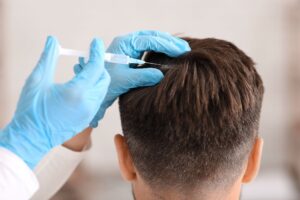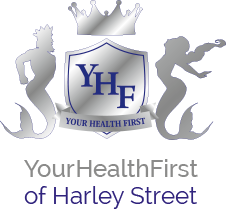PRP Hair Loss treatment – Doctors employ platelet-rich plasma (PRP) to hasten recovery from a wide range of injuries. Possible aid in regrowing lost hair.
Androgenetic alopecia, a frequent disorder that causes hair follicles to shrink, is a prevalent cause of hair loss, and the condition for which this medication is most often prescribed by doctors. The condition is known as male pattern baldness when it affects men.
PRP is a novel technique, however, there is some evidence that it may stimulate hair growth. In this post, we’ll go over how PRP is being used to treat hair loss in clinics and what the scientific literature has to say about the procedure.
What is PRP hair loss treatment?

To restore hair growth, PRP (platelet-rich plasma) therapy involves three medical procedures: blood extraction, processing, and scalp injection.
PRP injections may stimulate and sustain hair growth in certain people because they increase blood flow to the hair follicle and the diameter of the hair shaft. This method is sometimes used in conjunction with others, such as drugs or surgical techniques, to treat hair loss.
Insufficient evidence suggests PRP is beneficial for treating hair loss. In contrast, PRP treatment has been around since the 1980s. Damaged muscles, ligaments, and tendons have all benefited from its use.
Who could benefit from PRP hair loss treatment?
Androgenetic alopecia, often known as male-pattern baldness in males and diffuse thinning of the hair in women, is a condition that PRP has been found to improve in both sexes.
People who could benefit from PRP include:
- Hairless males
- Menopausal hair loss and thinning are common experiences for
- People whose hair loss started within the past five years (beyond that time, hair follicles have likely shrunk and thinned to the point where encouraging growth won’t make a difference, says Khetarpal).
PRP hair loss treatment can serve multiple purposes.
Injections of platelet-rich plasma (PRP) are used for a variety of reasons, ranging from the treatment of musculoskeletal pain or injury to the enhancement of physical appearance.
Injuries to the Muscles, Tendons, and Joints
Injections of platelet-rich plasma (PRP) may help with a variety of musculoskeletal issues. In the case of chronic tendon injuries, like tennis elbow or jumper’s knee, where recovery might be slow, PRP injections may speed up the healing process, reduce discomfort, and allow patients to return to their regular activities sooner.
Recovery From Surgery
PRP was first used by medical professionals to hasten recovery after a jaw or cosmetic surgery. Due to the lengthy recuperation durations after surgery on muscles, tendons, and ligaments, the use of PRP injections has recently spread to these areas.
Osteoarthritis
PRP injections have shown promise in alleviating the symptoms of osteoarthritis, such as joint pain and stiffness, according to a preliminary study.
Loss of Hair
Injectable PRP has shown promise in treating baldness in men by inhibiting further hair loss and stimulating the development of new hair. Similarly, PRP may help stimulate hair growth after a hair transplant.
Methods for Revitalizing the Skin
Injections of platelet-rich plasma (PRP) are occasionally utilized as an anti-aging therapy, despite the lack of data demonstrating that PRP effectively diminishes wrinkles and other symptoms of age.
Procedure
The following is an example of a typical protocol for PRP injections to treat hair loss:
- Someone’s blood is being taken from a vein in the
- The blood sample is centrifuged to separate the
- Blood is spun in a centrifuge to separate its various
- A syringe is used by a medical expert to remove the
- The platelets are injected into specific locations of the scalp by a medical
A total of 1 hour may be required, and many sessions may be required. There are often no restrictions placed on a person’s daily routine after PRP therapy.
Cost of PRP hair loss treatment
PRP therapy generally comprises three sessions in a 4–6 week period, with maintenance sessions every 4–6 months.
The price normally varies from $1,500–$3,500 for the first three sessions, with a single injection costing $400 or more. The following are some of the variables that affect pricing:
- Location
- Equipment
- Supplementary nutrients
Most health insurance policies do not pay for platelet-rich plasma (PRP) therapy to cure hair loss because they see it as a purely aesthetic procedure. To find out whether PRP treatment is covered by your insurance, you should contact your provider.
How long does PRP hair loss treatment last?
The ailment that causes hair loss cannot be cured with PRP. As a consequence, repeated PRP treatments are necessary over time if the benefits of hair growth are to be preserved. The same holds for topical minoxidil (Regaine) as well as oral finasteride. Two drugs are often prescribed by physicians for the treatment of androgenetic alopecia (Propecia).
The doctor’s suggestions for how frequently a person should get PRP may vary based on a person’s condition. As well as the outcomes of their first treatment. Once hair loss has been brought under control, your doctor may recommend that you return for maintenance treatments every 3 to 6 months.
Conclusion
Medications like Rogaine as well as Propecia, as well as surgical procedures like hair transplantation, are available to those who are worried about hair loss. PRP treatment is another option to think about.
Many people think that PRP is a safe as well as and effective method of reversing hair loss and encouraging new hair growth, even though there is minimal scientific evidence that PRP for hair loss works.
Please see your physician to determine the most appropriate course of therapy for you.










